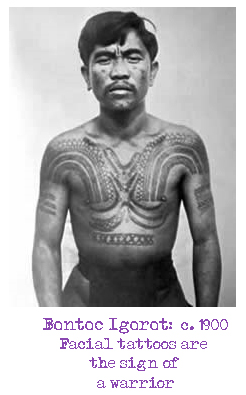It's tattoophilic
A genuine tattoo.... tells a story, It tells people what you are and what you believe in, Its a true poetic creation, and is always more than meets the eye. As a tattoo is grounded on living skin, so its essence emotes a poignancy unique to the mortal human condition.
-V. Vale and Andrea Juno, Modern Primitives

Tattoo may sounds taboo for some, it is commonly associated with people from prisons like criminals, gangsters, yakuzas and probably worst terminologies from other culture especially in an environment were stereotyping, prejudices and stratification are well appreciated.
In a unique and a distinctive culture like Hawaii, Japan including Philippines (in some hinterland villages) tattoo practices have been part of community's daily rituals it is believed that having it, is a manifestation of bravery, leadership and power of ruling clan and protecting tribes and whoever may have it were respected.
In my own perspective having a tattoo is a matter of choice and each and everyone has the power and an option to decide, each one culture may change but it will mark and leave its distinct forever .
I currently have three tattoos and been wanting to add more, the first one i had was the "koi fish" at my left leg symbolizes the " the Ying and the Yang, the second one is at the right leg a Tribal-like derived from a polynesian design and the latest i got symbolizes the naughty part combined with fun which is characterized by a lawnmower stick-man as it animates the scrapes and bush-clearing.
Tattoo History in the Philippines
Tattooing has been a part of Filipino tribal life since pre-Hispanic colonisation of the Philippine Islands, When the Spanish first landed in the Philippine Islands, they were met by the tribal people of the Visayas, who had full body tattooing, the Spanish dubbed these Islands as "La Isla De Los Pintados" or "The Islands of the Painted Ones".[1] Tattooing in the Philippines is a tribal form of rank and accomplishments, some tribes believed that tattoos had magical qualities. The more famous tattooed Filipino tribes where the tribal peoples of the mountains of North Luzon, especially among the Bontoc Igorot, Kalinga, and Ifugao peoples, which were infamous for Head-hunting. A tribal member received a tattoo (known as a "Chaklag") which meant they have taken the head of an enemy tribe or warrior.[2] There are many very different variations, traditions and styles of tattooing in the Philippines, most depend on the region and tribe they come from as each vary.[1]
Filipino tattooing was first documented by the European Spanish explorers as they landed among the Islands in the late 16th century. Before European exploration it was a widespread tradition among the islands. Tattooing was set around mostly Tribal groups of the Philippines, which tattooing was a sign of Rank and power in the tribal community, many Tattoos could only be attained by accomplishing a task, or passage of rites.[2] Women in Filipino tribal society also traditionally tattooed themselves, and tattooing was seen as a form of beauty among women. Notably women of the Luzon mountain tribes received full arm and chest tattooing, whilst in the Visayas and Mindanao they typically only tattooed their hands and wrists.[1] - WIKIPEDIA
Visit: http://baybayinalive.blogspot.com/2010/11/giving-symbols-meanings-is-ancient.html
Learn your own culture! ItsTRAVELTIME!